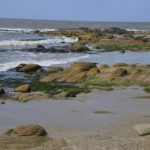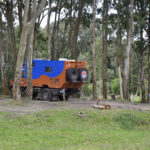For English version click on “BEITRAG LESEN/READ THE POST” and then scroll to bottom
Ab heute sind wir wieder mit Albatros on Tour. Wir packen morgens alle Sachen und dann heißt es warten. Gegen 13:00h kommt die erlösende Nachricht. Ralph wird abgeholt und kann Albatros in Empfang nehmen. Gegen 16:00h haben wir unser Gepäck eingeladen und fahren zum Stellplatz am Leuchtturm. Nach und nach trudeln immer mehr Camper ein. Letzlich sind wir 4 Wohnmobile aus Deutschland, 2 aus der Schweiz und 1 aus Frankreich. Wir laufen noch kurz zum Supermarkt, damit wir was für das Frühstück haben und sind früh im Bett.
Am nächsten Morgen geht es weiter zum Paraiso Suiza, einem von Schweizern geführten Campingplatz, auf dem die “Zimmermanns” ihre Gasflaschen für uns abgestellt haben. Unterwegs fährt Ralph an einem Strand raus und wir stellen fest, dass unser Druckluftschlauch undicht ist. Das fängt ja gut an. Wir machen nochmal einen Einkaufsstopp und während ich durch die Gänge laufe und die nötigsten Sachen zusammensuche, versucht Ralph, die undichte Stelle zu lokalisieren und zu flicken. Als wir weiterfahren geht der Druck gerade mal bis auf ca. 7 Bar hoch; normal wären ca. 18 Bar. Also, stoppen wir nochmal und Ralph baut den Schlauch halb ab, damit er ihn mit selbstverschweissendem Band umwickeln kann. Als das auch nichts hilft, klemmt er den Schlauch mit Kabelbindern ab und wir retten uns noch bis zum Campingplatz. Dort werden wir freundlich empfangen und Heinz, der Eigentümer, ist zuversichtlich, dass man uns im Nachbarort helfen kann. Wir verbringen die nächsten Tage mit Wäsche waschen, Strandspaziergängen, quatschen mit den Nachbarn, Walbeobachtung (leider zu weit draußen um gute Fotos zu machen) und ein- und umräumen unserer Sachen. Am Freitag kommt der Druckluftschlauch und wir sind wieder fahrtüchtig. Ralph hilft einem anderen Deutschen noch bei dem Versuch, einen Reifen nur mit Montiereisen von der Felge zu bekommen. Es gelingt tatsächlich. Allerdings überschlägt Ralph sich dabei einmal und zieht sich im Gesicht ein paar schöne Schürfwunden zu. Weiter geht es über Piriapolis, wo wir die Gasflasche auffüllen lassen und das Castillo Pittamiglio besuchen, nochmal zurück zum Stellplatz der Deutschen, mit denen wir über eine neue Tür sprechen. Danach geht es zurück zur Küste. Die nächsten Tage folgen wir mehr oder weniger dem Küstenverlauf und fahren über Punta Ballena, Punta del Este, Faro José Ignacio, Playa Arachania, Cabo Polonio, Punta del Diablo bis zum Nationalpark Santa Teresa. Drei Tage lang haben wir mehr oder weniger Dauerregen. Bei dem Versuch, einen Stellplatz an der Playa San Antonio anzusteuern, fahren wir uns in weichem Sand fest, kommen aber mit ein bisschen Buddeln und ein paar trockenen Zweigen (die lagen schon neben der Strasse) schnell wieder raus. In Cabo Polonio lassen wir uns mit alten Off-Road-Fahrzeugen durch die Dünen an den Strand fahren. Dort gibt es ein Dorf, dass noch sehr minimalistisch ist und nur mit diesen Fahrzeugen, die für die Bewohner die öffentlichen Verkehrsmittel sind, erreicht werden kann. Da wir noch Vorsaison haben, sind viele Buden noch geschlossen, aber wir bekommen einen Eindruck, was hier im Sommer los sein muss. Am Leuchtturm wollen wir an der Küste entlang zurück zum Ort laufen und entdecken einen Vogel, den Ralph fotografieren will. Dabei kommt er wohl einem Nest zu nahe, denn der Vogel fliegt regelrecht mehrere Angriffe auf ihn. Eigentlich wollten wir von Cabo Polonio aus noch an die Laguna Negra fahren um dort Vögel zu beobachten, aber schon nach kurzer Zeit stehen wir an einer Art Rampe, die für uns unüberwindlich ist; wir sind zu breit und die Rampe würde wahrscheinlich unter unserem Gewicht zusammenbrechen. So landen wir dann schließlich auf dem Campingplatz des Nationalparks Santa Teresa. Hier besichtigen wir das Fort und nutzen die Tatsache, dass wir Strom haben, um alle Akkus aufzuladen. Bevor wir uns nach Chuy an die brasilianische Grenze wagen, verbringen wir noch eine Nacht am Strand von Puimayen. Da es sonntags ist, sind viele Einheimische am Strand. Manche sitzen einfach nur in den Dünen und schauen aufs Meer. Andere laufen den kilometerlangen Strand entlang. Alle genießen einfach nur das schöne Wetter und die Natur. Chuy wurde uns mehrfach als Freihandelszone mit besonders günstigen Preisen empfohlen. Als erstes landen wir in einem Laden, der uns an die Duty Free Bereiche am Flughafen erinnert. Die Preise haben es in sich und wir fragen uns, wer dort einkauft. Als wir die Straße weiter laufen, stoßen wir dann auf kleinere Läden, die von Einheimischen betrieben warden. Hier kann man dann schon eher günstige Sachen sehen. Unterm Strich ist es aber immer das Gleiche angebot; Sportartikel, Handyzubehör, Werkzeuge, Parfüm. Interessant an dem Ort ist, dass die nach Westen führende Seite der Straße brasilianisch und die nach Osten führende Seite uruguayisch ist. Die Grenzkontrollen kommen aber erst ein Stück später. Wir fahren noch zum Fort San Miguel, das wir aber nur von außen besichtigen können, ehe wir einen schönen Stellplatz am Fluß finden. Ab morgen warden unsere Etappen wohl etwas länger werden.
English Version (no translation of German text)
Albatros is on tour again. In the morning we pack all our things and then wait for our agent to call which finally happens around 1 pm. Ralph is picked up and can release Albatros from customs. Around 4 pm we load our luggage and then drive to the lighthouse in Montevideo where we stay for the night. We are not the only ones spending the night there. At the end of the day we are 3 German, 2 Swiss and 1 French camper. We buy some stuff for breakfast and then go to bed early. Our next destination is Paraiso Suiza, a campground run by a swiss couple. Friends left their gas bottles there for us to pick up. When we stop for a beach walk, we hear that our pressure system is leaking. What a start! During a shopping break Ralph tries to find and fix the leak while I try to find the most urgent things. However, when we continue the pressure only goes up to approximately 7 bar; 18 bar would be normal. So, we stop again and Ralph partly dismantles the tube to better wrap it with self-sealing tape and uses cable ties and somehow, we manage to get to the campground, where we get a friendly welcome. Heinz, the owner, is confident, that a mechanic in the neighborhood can help us. We spend the next couple of days with laundry, beach walks, talking to neighbors, whale watching (to far off the beach for good pictures) and rearranging our stuff in the camper. On Friday we get the new tube and shortly thereafter are all set again. When another German camper tries to dismantle a tire from the rim with only some basic tools, Ralph wants to help. They are successful but at some point, Ralph skips and ends up with some nice grazes in his face. We continue the trip via Piriapolis, where we get the gas bottle filled and visit Castillo Pittamiglio, back to the campground of the Germans, with whom we talk about a new cabin door. Then we drive back to the coast which we more or less follow for the next couple of days. Via Punta Ballena, Punta del Este, Faro José Ignacio, Playa Arachania, Cabo Polonio, Punta del Diablo we reach Parque Santa Teresa. For 3 days it is raining most of the time. When we try to reach a place at Playa San Antonio, we get stuck in wet sand but with a bit of shoveling and some branches from trees (they were already lying beside the road) we get out relatively easy. In Cabo Polonio we take the off-road trucks to get through the dunes to the beach. There is a small village with only a minimum of modern technology. It can only be reached with these vehicles and they are public transport for the inhabitants as well. Since it is still pre-season a lot of the huts are closed but we get a feeling, how this will look like in Summer. From the lighthouse we want to take the track along the coast line back to the bus station and discover a bird of which Ralph wants to take a picture. It seems he’s come to close to a breeding place. One of the birds attacks Ralph multiple times. Initially we planned to go to Laguna Negra next. However, shortly after we left the highway, we see a ramp that is not passable for us; Albatros is to wide and most likely to heavy for it. Thus, we turn around and finally end up on the campground of National Park Santa Teresa. We visit the Fort and, since we have electricity, we charge all batteries. Before we move on to the Chuy at the Brazilian border, we spend one afternoon and night at the beach of Puimayen. Since it is Sunday, a lot of locals are at the beach. Some just sit in the dunes and watch the sea. Others take walks on the endless beaches. All just enjoy the nice weather and the beauty of nature. A couple of times Chuy was recommended as a cheap tax-free region. The first shop reminds us of the duty-free areas at airports. The prices are high and we wonder who is going to shop there. When we walk further down the street, we see smaller shops run by locals. They obviously have the cheaper stuff but at the end it is more or less the same things again and again; sportswear, mobile accessories, tools, perfume. The interesting thing about Chuy is, that the roadside leading west is Brazilian and the roadsice leading east is Uruguayan. Border controls take place at a later point. We continue to Fort San Miguel but since it is closed, we can only visit it from the outside. We find a nice place for the night at the river. From tomorrow on our daily trips will most likely become a bit longer.


















































Hallo Ute.bekommst du meine e.mai bzw
Kommentare?.es ist der helle Wahnsinn was so alles passiert.ich dachte, unsere reisen nach Australien Outback ,Urwald und quer durchs Land,wären das Nonnplusultra,ist aber zu euren Unternehmungen nur ein Weg um die Ecke
Weiterhin toi toi toi